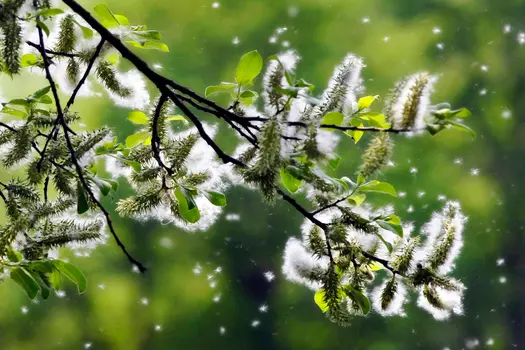March 16, 2022 -- Climate change has already made allergy season longer and pollen counts higher, which will continue to grow worse in coming years, according to a new study published in the journal Nature Communications.
Pollen season could start 10-40 days earlier and last 5-20 days longer, with pollen levels that could triple in some places if carbon emissions aren’t curbed, researchers found.
Warmer weather allows plants to start blooming earlier and continue to bloom later in the season, while carbon dioxide in the air from burning fuels such as coal, gasoline, and natural gas helps plants produce more pollen, Allison Steiner, PhD, one of the study co-authors and a climate scientist at the University of Michigan, told The Associated Press.
The research team looked at 15 plant pollens in the U.S. and historical pollen data collected from 100 sites across North America. They used computer simulations to calculate how long the allergy season will get and how pollen emissions will change as temperatures rise during the next 80 years.
They found that temperature and precipitation will affect daily pollen emissions based on the region and type of pollen. The annual total pollen emission could increase 15% to 40% due to seasonal change and temperature-driven pollen production. What’s more, rising carbon dioxide in the atmosphere could increase pollen production by 200% by 2100.
Allergy season has already grown worse in recent decades, the AP reported. Allergists say that pollen season in the U.S. used to start in mid-March around St. Patrick’s Day and now often starts in mid-February around Valentine’s Day.
Across the U.S. and Canada, pollen season is starting about 20 days earlier and pollen loads are about 21% higher than in 1990, according to a February 2021 study published in the Proceedings of the National Academy of Sciences. The researchers found a strong link between global warming and longer pollen seasons.
In the most recent study, the research team found that the allergy season will be worst in the Southeast. The start of alder tree pollen season would shift forward most dramatically, which could cause issues for the Pacific Northwest. Cypress tree pollen, which is particularly strong in Texas, would see among the highest increases.
Ragweed and grasses, which spark the most common pollen allergies, will also have longer seasons and higher pollen counts, the researchers found.
About 30% of the world and 40% of American children have pollen allergies, which can lead to lost workdays, school absences, and high medical costs, Yingxiao Zhang, one of the study co-authors and a climate scientist at the University of Michigan, told the AP.
Allergies are especially tough for the 25 million Americans with asthma. A longer and more severe allergy season could worsen their condition even more, the AP reported.
Historically, trees have been dominant during the spring pollen season, followed by grass in the late summer and ragweed in the fall, according to NBC News. But in the new model, those seasons will overlap in the summer, which could multiply problems for those with allergies and asthma.
“We think of allergies as stuffy noses and itchy eyes, but it also underlies asthma, which is a more serious condition,” Patrick Kinney, PhD, an environmental health professor at the Boston University School of Public Health, told NBC News.
“People will probably feel worse and need more medication as time goes on, and more people will likely become allergic to pollen as well,” he said.
